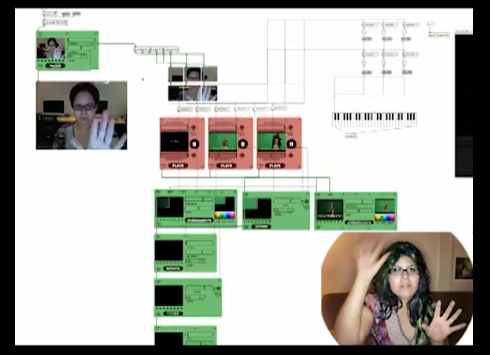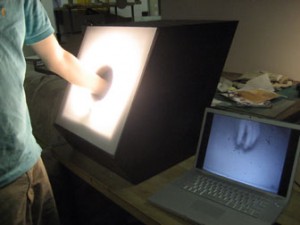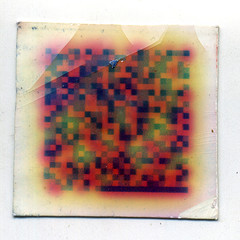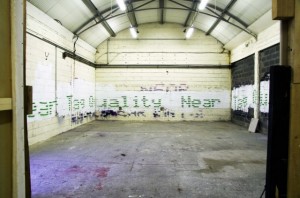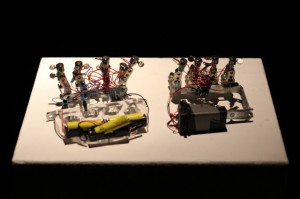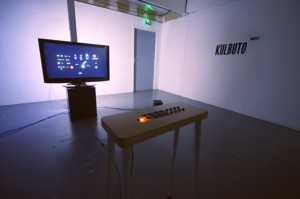http://www.youtube.com/watch?v=geby7tjpEM0
Made for Electronic Media Studio II at Carnegie Mellon University under professor Golan Levin and graduate student Craig Fahner.
This video depicts the operation of a patch made using MaxMSP using Vizzie controls. The screen is divided up into 6 sections (3 columns and 2 rows) that detect the amount of motion made in each. If the motion exceeds a threshold, then commands are sent to control audio and visual noise effects. The screen is chromakeyed and the FOGGR is used based on which sections of the screen detect motion. The controls are as follows:
- The top left portion controls nothing.
- The top middle portion (where the head is typically located) controls the amount that the chromakeyed color fades to FOGGR noise, and the probability of the FOGGR
- The top right portion controls the amount of blue (0 to 255) in the chromakeyed color
- The bottom left portion controls the amount of red (0 to 255) in the chromakeyed color
- The bottom middle portion (where the torso is typically located) controls the tolerance range of the chromakeyed color
- The bottom right portion controls the amount of green (0 to 255) in the chromakeyed color
Each section also controls a range of audio that is played, ascending from top left to bottom right (in the order listed above), motion in each section will play a range of sound from:
- 0 to 60 hz (top left section range)
- 0 to 100 hz
- 0 to 200 hz
- 0 to 400 hz
- 0 to 800 hz
- 0 to 1000 hz (bottom right section range)
respectively, based on how much motion is in each.
The purpose of this project was to experiment with both audio and visual noise, how they interact, and how they can be combined to create and interesting and involved interaction between user and computer.
Patcher Code:
<pre><code>
———-begin_max5_patcher———-
3890.3oc6c0sbaaqD9Z6mBM55TV7O.OWblbdN5zICkDsLSoHUoncRSm1m8CH
fDEoCkHnHjDnMblXY9q18CK.VfuEK96GeX9h7uGua9r+yrea1CO72O9vCpSU
chG1e7Cy2D88koQ6T217r3uku3qy+j9RuFUjEsIVckWS9wORhObkx3uWpN81
Ysuv1nxkOmjs9KEwKK0ey7.vmlgwgUePgU+FAB.y988OwS4Yk0eK+uhjnzCu
qjUpyIEneAEd3jYurIIKMtTIuvimL+kxCmEz3MuK4Gp2LDE.ZJhwE6Qg8vf7
tSRieMtXWRdViW8Cyi1tswoenwiTgceMW8hnep9TIY5SAqOUQ7qIGd9P8I+m
GO75OhSPDPAUHh5CH.izeBPGgKYA35z7k+Q7pFZ5CyWE+zfeQ4aiyN9Pfpao
0uZemIYaKh2EmUFUtWUZ9kG8RZ4W5Fuae8mhVFexGtSyfGlutHYUdVkPz5Iq
N8guNoRSU5Hsobqtirnsc7vk44oKhJpJXVjF2p.WVCIJKYSTYbYhVdPf5mKY
y1hjrxVuq3rH4634cKKxSSa8pzW40NtxJoMwx3ukrp7Y065HZ0pNaSqsl0ca
c92TGtLe85zCUH0kep5Fk+018X0bkF76MtiNp1RYJDMDxNTkscE22VEkBZ9U
1U0zNppBObg+4wGO7Ge5B06Mw61EstkhW2Lkp7+bHR+vAhnfCBV0bltlk3Mv
woMheCXg4mDrPmFrdy2Ty5ZVDGa0GPaXbWUqL4Eq92Ynyhl6RVmI089vTFQn
vTlBM4vNMwLGSYSSLcYTZrrAfYvfpeinzfl2WyVca.cHpxbjhfc1j8kYiiPp
BBJln6ufNxBD5IKPXu6JPfLr1AmPKVf.QpJHDN0NEHj2iEHW.rxzUd.VxNG9
d.VktGBFGrxCU.ICJzvZ33fUR36AXULZTkqfSFApQUzHQUw6ATkLVTkoaRko
8qc7nJ5cQKqiFUoHssJxNn56kFVG4POnXc6pb6fpf2CnJarfJTappGIW3XcA
XZ1p5x+ZYZ7+Zigxw4D8X3zNrNR3DMMGdr8fSpdvv1BNoezgS.2lvI4CNbx0
iXxVvI3CNbxvLKBmPG157ozb426YwL4sDUN+SyluHJacuPmHDnGIuP+wH8Lh
eASgMZhBcbZnMgN1GHnS.2Ccbq.czOPPGCC0XFyJPG4iDzEZUqN7GHnixQVD
5vgtKzcSbXQPrp+egtqCKw+XUzxVXVWULYJCJtlZXMbPnmlobzkPToM0pEGB
AlVzZkWlWYJTWlsM46sJxVrdS9p32B9cQux94BP+ARnmhU3Yhc.X6t.OFyQw
eq3WTeCAREXaUM9AWwCz3JQEq2GZEy98a7rVIcTUM4UibVqz8A.0NfL5YsB6
tyZUW1nMiGsmxWudusgMLi+ohhulT9kMQkEIeu+Nl0QHCW+gt2EXE+7mxbGi
5zbugJ0m4NwnhmIu4NVnmx68wdyXM2ASWy8kOWjuI5Oh+qhqs0tzmp5+2+jn
q7mR2POF2ukORzok+QsyLye9IKtH2Uy+WVscWb1JowgztU9OXUrX1l9mtrxC
0CFRilPcTaNB+ovirWx6i6oaKh2Vgc+pTvVzthvva3f.zQiikn2EgtjXabhN
XIhdr4jPjMFrDBNIGrjk6HiHzwDi1dbrcjAm3QFicvTjfowTpUvTgGSkCc6f
CWVgUbH2io+1rCU8EVARYtKjpDk4VZPUD8jcpmBA5geexIP3z97.LBVVluYS
rdccLetSOUlTc3.hsQmyPzGnIAln6uvRHG7iDxom2bKgbfOPHGVS2kcPtvOP
.29oQyN.m3CDvA4VzhiOIG6lDLhSdMd1N1Xi6Vwwk9HajNtwFoCJ2YnjN1w+
pGqVnMfR5zFJIicps31ypjLsgR7HoW.CsGThm1PIZjSFywtZFOThl1P4XmCF
tEsJgWen7X9VHMI6Tot.kdVc8tw3c4uTr7.BcHnPl0VmWEuqLIqN8S7aGW02
yfstwmSVspc5dPmXNVsMOIqbXTBcckaf6H27IJdymn3MXhh2foIdWEU7SQ7d
XxsCYeSmn12zIJdOQsuQST6a7DseG5Ds8aro1IUQXzLj6H2vgH2X2QtoCQtI
tS+kBSsuoWl8MJjFPqFQ19zZ39wm07HhPM4qHLq5NUGcsJkvlpsvKSaY.gRG
n5DPDGWez0RiLt8IxkoQUAaWkNfUJFDyqO5dWFQ3tkGylNRVB0s5ovTKHhiM
BESa4hfcK41TOgHD2RtYl1RS3kI2g5lVzI2Pp.Vez8tBqpKa5vUHhVivHf5C
XX.S9Cks+T2a6KkZwFtZA08HTkQEqTKNr9nq0XdLslNzsZY0TWYcq9wPFJ0B
2pWLCk5PmRpMcPZPfaMnXSEanSI1l1AFD4VUHMdHwNlbaZKIHGyAM7P5.8Bj
apZnT6itRvg+9JoMl5M.zs7t23t7cqNOM0kRna06IzzlXftU+mPim8CvzrIF
ra0jNFMjlFu.VS3T8T.hTS1DDEfq9gs+TWqRCS0J7DclDTEaSPNrPrIrbOA4
VFMQ4VFMQichIsbOAiwFzDMllPSzXHCMQiYOzDMFIcM7NbZh2DiqW5Vy2Lwz
1uIt0ngHFO5S2hQLhwLU6VyCJw3Qw4X1IlNAtD2ZTyDSmLKjaMYVDS8+l3Vy
lEw39cbL1fLNx.bK4Far8sa09M130dhMsu2exC6nsy2E8Z7puH+ZhWV9knxx
hjEuTpWVPMTfQuovdlK029Q65z7EQo6S3d0uiVu4eRh5bcPoQA0u0keCeKV9
XRmoJ2mUuhk6b0JteKqRGcg58DnKXmTVXgcRYaq1zyo15T41XUatCp1jyn1H
rUTalCp13yn1PcxTcrpM0AUazYT6PgMzZhCp0vyU0FZCsF6TZ81Y6j5mr+15
ZdmdE.2cq76yeGhtW9uFBJnA.JvS.JMEx3h21A9SIowuFWbXisudmMOZ61Fm
tkSKR.7q4pWD8S0mJISep5Uc77h3pskc8yG93CM8tn5hGapPmk5P5zzgPmqv
3Xbys.9ExN6W9Gwqdq6EC70Ts+ge7Q.M2heauO+ptyjrlaRvmzylt7MYrtEU
sk22w1ce0oO70IUYcz72Lepouirnsc7vk44oKhJpJTVj1JWBWUEIJKYSTYbY
hVdPf5mKYy1hDcNUq9bwYQx2wy6VVjml15UouxqcbkUR6gkweKYU4yp20QzR
90epEbtYKmecsf4FkLYwgXyRFciM+61LWz8Zxp37Yxabtqln9v5jqKDBMLU8
YwL0mFcRxleaxvCRTI.e9j0zfRe13PR.mRIXjz5hDFv3LJmJ6JLTuDit37mw
kjvqH2lDnQEFt8aIYqx+V+.YuYcDHKfHDgXtD.on.BPvvUqSIPff.3UXIDgC
nH.h.OYNI+hxxUNc95qJOKgXgPIrfBQAHoIVH0B4xY1jLefUYxkuc1mk+++N
6yuFkJ6BANe.oC+dqGCwADtzO1JyPDJ.SY.nnx1icG13NcJ.OZwtUIO8z0Bs
kF4AbFNjyqxx636v9548Gsk.250wEyRmkN9VTwPR.jFJnvpEvJJ.FJPDT0d7
vcXSIvMrjW9rrM2X6ZA2.jAf.NOjgwU6F8Ws7BuqCxEqWfReYSz0.lER6WHC
JcIfKDzpw1c0RU7VCluJIUKiWhotVXQGNMW4EH1PB7hoXfJxmlIAGGKPWP3g
P3Hzsja3zinTD8JuhntyK.WGa03zwhm3D7R6ok10nktlNC7kQmAjse6pfOJ5
Lfd5L7zY3oyvSmgmNCOcFd5L7zY3oyvSmgmNCOcFd5L7zY3oyvSmgmNCOcFd
5L7zY3oyvSmgmNCOcF8QmA8BWcF.hMVcF.OcFd5L7zY3oyvSmgmNCOcFd5L7
zY3oyvSmgmNCOcFd5L7zY3oyvSmgmNCOcFd5L7zY3oyvSmgmNi9nyfbYzYf1
yiw3ny.x8zY3oyvSmgmNCOcFd5L7zY3oyvSmgmNCOcFd5L7zY3oyvSmgmNCO
cFd5L7zY3oyvSmgmNCOcFd5L5iNCzElrozyNHCSGCcFXOaFd1L7rY3Yyvylg
mMCOaFd1L7rY3YyvylgmMCOaFd1L7rY3YyvylgmMCOaFd1L7rY3YyvylgmMi
ys+mW9bQ7tmySWclsAcjPM84PfZHuhvKbUXDde1GzaMELlN8KmAFX5cCdvEh
BhAfBH6gBKNP0y9W4qQGsC2FkkU7Kpan1JnHuLuBkNdSIeuVeVrdS9plrEXz
rL2ElFplYYHQnmZYfl7BRCTsI1Uuk02knGH02sQkcBu3yRNVTw5VM2LPn8mm
1ydFfdW.ACnPBJS8gPADLvIvA5PrgtWZDEAzZD1.MhLEzHhdYnYVYDdRTFEF
paLCXfFglDZDTUFQzJVOZDbZX0wMuLBbk0nS3JQkhtaYxtc4E6l84h7usaFZ
1mWlm9xlrcyN8VyU6Y8wNGc99v0S1IgqI1TvurdwGhqLb60IdegkB7BSZnTK
rHa8qwVeTo3iJEeTo3iJEeTo3iJEeTo3iJEeTo3iJEeTo3iJEeTo3iJkOpQk
xDkUyIJIxSVR6mpAIwTMnTlpAAzDMnqlpA41TMnB8QkxDHpTrB4XBgzgKtbr
YxwACki8kCvPTeyGSSWqDWYBy1DuaWTsy7GcAcYZ9t3KLonBAAXl.hIROKYA
PoWmUSCPnlQqgxaCqS..MHdarHtn3B3xVb0LQ.GPvvJGtoABHgHjHjl8zgiK
z6CtTludc5oMLTrabt3oQZqyQBjbrcDV.gPBAB8HOdCmdMzzgD6EP6wZ4etI
trHeFFbRks2HxpZlFALA.opHPB4jPwH10CuOk3mgR8+rLXcQzhYXDXFh.LjF
89fLLiAPUSVHPDHDLDmU82WHS3P6FNapu71i.Uigu0Ef8HYOtrXj6J+be9c2
e+OUtZpLEZfHwuoRDjYfHMPPBB.UjHgAZtjXr5itEBq31helXjwt4FYz9DI5
vDIBPUHVEvaxOXPP8QVPXI8IrjgIrXtPIdZtLonv5irfvh6SXwCTXofFBKgv
sovh5SXQCTXQHkTFRTlA.Q8QVPXg8IrvgIrHsTJcFPE0bHd8Q2fVwqh+tAIr
5VIktsnhJMxwiFovRLPXQ2z1mPl.e2TIh5bRDy4jHSpghu4RTeMvgt8fTucP
vu4hTecvh.NmCJnaaaRbSZk71ZdiMQjH21VtMwaWD815.tQEc2VOveS8ISXT
45KSlzsKR3dC9DMlgnKO3ed7+Cv4nRGE
———–end_max5_patcher———–
</code></pre>
